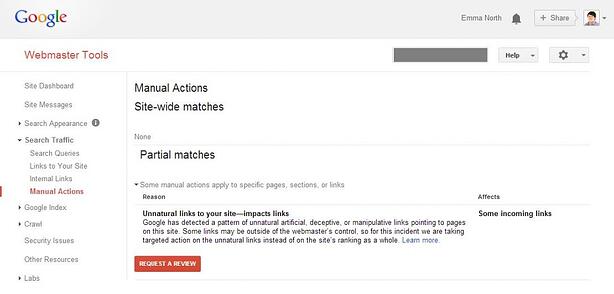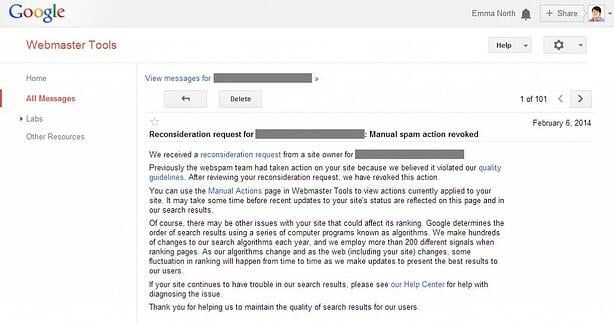For many of us in the business, the process of modern day SEO includes the undoing of previous optimisation efforts. This generally means the undertaking of backlink analysis, link removal, nofollowing old links and disavowing spammy domains. These processes help to ensure that link profiles are seen as natural by the search engines and are as close to future-proof as possible.
But for some websites who have seen the back of Google’s strong hand in the last two years, these processes are less about housekeeping and more about manual penalty recovery.
In this post I’ve looked at the process I use to overturn one of the most commonly distributed types of manual penalty; the partial match unnatural links penalty which "impacts links":
What is the significance of a "Partial Match" penalty?
This simply means that the penalty or action taken only affects some parts of your site. This could be a page, a section of your site, a link to or from your site, or a number of any of these.
This is generally the good news; it is much harder to recover from a site-wide issue which could mean the deindexing of your entire site. Instead, the actual penalty or action is likely to be minimal and you may not even notice any significant changes in rankings or organic traffic.
The most important thing about partial match action is that Google hasn’t completely lost trust and faith in your entire site and this fact makes recovery not just possible, but genuinely achievable with the right work.
What does "Impacts Links" and "Targeted Action" mean?
This means that the manual penalty is not designed to impact your site or pages but the unnatural links themselves. However, this does not mean that your site isn’t in anyway affected.
Despite the way this message is worded, there is strong evidence that this type of manual penalty does contribute to drops in rankings to some degree, even if that is just because of the loss of value that was once received from the now flagged links.
This is why it is so important to get this action lifted by clearing up your link profile, getting rid of any potentially harmful links and requesting a review in Webmaster Tools.
Where do you start? Backlink Analysis Tools
The first thing to do when manual action strikes is to collate as much data as possible on your website’s backlinks. This includes the linking pages, referring domains, referring IPs and link anchor text.
No single backlink analysis tool can give you 100% of your site’s link data. Each tool you use will find as many links as it can find but it is believed that you will only ever see around 30-50% of your site’s backlinks.
This is why you should use as many different tools as possible to collate and analyse your data. These should include as many as possible from the following list, but at least the first four:
- Google Webmaster Tools
- Bing Webmaster Tools
- Majestic SEO
- OpenSite Explorer
- Ahrefs
- LinkRisk
- Link Detox
- Open Link Profiler
- Web Me Up
Review and export as much data as you can from these tools to give yourself the best chance of identifying as many bad links as possible. Collate the data into a spreadsheet and remove duplicates until you have a wealth of data in one place to analyse.
What makes an unnatural link?
When you have your data it’s time to analyse it and flag up any links or domains which need action. But what are you looking for? What does Google see as an "unnatural link"?
Here are the sorts of checks you should carry out when reviewing each link:
- What is the link anchor text? Does it or could it appear too spammy, unnatural keyword anchor text or is it natural or branded? Unnatural use of over-optimised anchor text is targeted by the Google Penguin algorithm update and can also contribute to the issuing of manual penalties.
- Is the link followed or nofollowed? Generally nofollowed links are not seen as unnatural as the flag indicates to search engines that the purpose of the link is not to flow PageRank.
- How many pages does the website have indexed in Google? If the site has far fewer pages indexed than it appears to have on site, this could be a sign of deindexing or low value.
- Does the site have links to social media profiles with a strong social following? Strong social profiles with lots of followers and engagement suggests that the site is used by real people. This is a good sign that the link could add value to users and was not placed just for search engines.
- How does the site look and feelin terms of quality? Sometimes a spammy site is easily identifiable without much analysis at all. If the site looks like it could exist only to host content with spammy links and is not likely to be seen or used by actual readers, the link is not going to be providing any value.
Top Tip: Install two Google Chrome extensions to get a wealth of information on the linking site at the click of a button. The SEO for Chrome and Majestic SEO Backlink Analyzer extensions allow you to quickly check the PageRank, number of pages indexed in Google and the strength of the sites’ own backlink profile.
Using a combination of these sorts of checks you can build a picture about the website and the link to work out whether or not the link is likely to be considered unnatural by a search engine.
This might seem like a lot of work, especially if you have hundreds or thousands of links to review, but this process will become very swift with practice. After half an hour of link analysis you should find you can diagnose the necessary course of action (or lack thereof) for any link in around 10 seconds.
Removing, nofollowing and disavowing
After carrying out your backlink analysis and identifying potentially unnatural links, you need to start taking action to neutralise the potential risk the links pose.
Firstly, think about whether the unnatural link has any value to you for referral traffic or brand awareness. Are real people likely to see or follow the link? Check in Google Analytics whether or not you receive any traffic from the website before you blindly remove potentially useful links. It might be that getting the link nofollowed or just disavowing the domain is more suitable.
Whether or not you try to get a link removed, consider disavowing the domain if you feel that it could be considered spammy. Compile a list of any potentially spammy referring domains and submit this to Google to ensure that they are aware that you do not want any link value to be passed from those sites.
Submit your Reconsideration Request
When you have been through all your links and taken the action you deemed most appropriate, it’s time to submit your first reconsideration request.
Here are my tips for writing a successful reconsideration request message:
- Be honest. Google does not want to see you try to dress up the situation and wants to know that you understand what was done wrong in the past.
- Don’t try to blame someone else. Accept that the activity took place and explain how that came to happen. If the links were built by a previous agency or staff member, feel free to mention this but don’t try to deny all knowledge of what was going on.
- Explain that you now fully understand the guidelines and are abiding by them moving forward.
- Sign off with your name and position, not just the website or company. Try to make the request as personal and genuine as possible.
- Don’t overdo it. Remember that these messages are being reviewed by people, not robots. Keeping the message to-the-point will increase the chance of it actually being read and getting a personal reply.
Pick yourself up and try again
Your first request is not always accepted. In fact, it can take numerous requests with continuing link analysis and removal effort in between each one.
The whole process can be very frustrating, or in fact very straightforward depending on your site and the depth of your analysis. However many times you get a request denied, the important thing is to keep trying.
With each message you receive from Google, check for any example links they may provide you with. Google is increasingly providing example links in manual spam penalty messages and denied reconsideration request replies which gives you the perfect starting point for your next link review and action plan. Before you submit another reconsideration request, make sure that you have dealt with the example links Google gives you, ideally getting them removed and disavowed. You can then reference the action you took against each of these specific links in your next request, showing Google that you are listening and working hard to get the situation resolved.
Don’t submit subsequent requests back-to-back without further link analysis and action in between. Google expects to see things change between your reconsideration requests and wants to see that you’re working as hard as possible to get the situation resolved. Then, and only then, will you succeed…
Manual spam action revoked!
This is what it is all about. It might take weeks, it could take months, but eventually you will receive this fantastic little message and give a little sign of relief:
However, getting a manual penalty overturned isn’t always the end of the struggle. If your link profile was particularly unnatural, it could be that your site is still not ready to stand up to the Google Penguin algorithmic review.
Keep cleaning your link profile, removing unnatural links and disavowing spammy domains as part of an ongoing housekeeping process to give your chance the best chance of ranking well in organic search.



